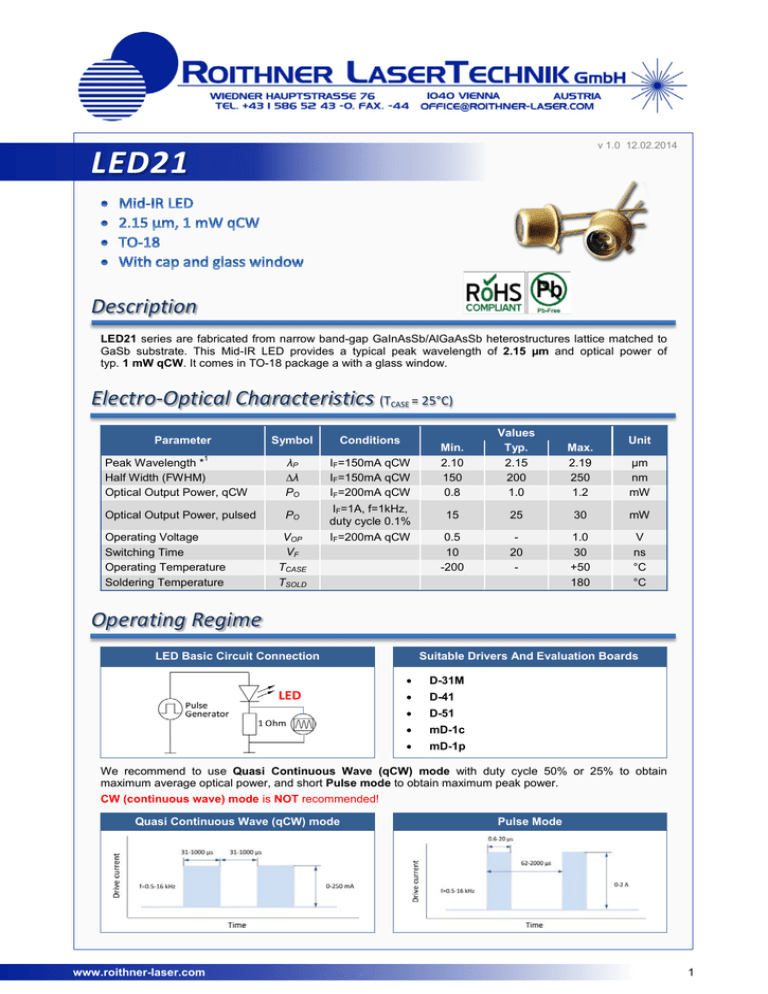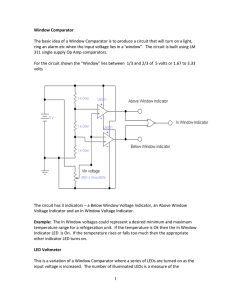
LED21
v 1.0 12.02.2014
Description
LED21 series are fabricated from narrow band-gap GaInAsSb/AlGaAsSb heterostructures lattice matched to
GaSb substrate. This Mid-IR LED provides a typical peak wavelength of 2.15 µm and optical power of
typ. 1 mW qCW. It comes in TO-18 package a with a glass window.
Electro-Optical Characteristics (T
Parameter
CASE =
Symbol
Conditions
Peak Wavelength *
Half Width (FWHM)
Optical Output Power, qCW
λP
∆λ
PO
IF=150mA qCW
IF=150mA qCW
IF=200mA qCW
Optical Output Power, pulsed
PO
IF=1A, f=1kHz,
duty cycle 0.1%
1
Operating Voltage
Switching Time
Operating Temperature
Soldering Temperature
VOP
VF
TCASE
TSOLD
IF=200mAZqCW
25°C)
Min.
2.10
150
0.8
Values
Typ.
2.15
200
1.0
Max.
2.19
250
1.2
15
25
30
mW
0.5
10
-200
20
-
1.0
30
+50
180
V
ns
°C
°C
Unit
µm
nm
mW
Operating Regime
LED Basic Circuit Connection
Suitable Drivers And Evaluation Boards
•
D-31M
•
D-41
•
D-51
•
mD-1c
•
mD-1p
We recommend to use Quasi Continuous Wave (qCW) mode with duty cycle 50% or 25% to obtain
maximum average optical power, and short Pulse mode to obtain maximum peak power.
CW (continuous wave) mode is NOT recommended!
Quasi Continuous Wave (qCW) mode
www.roithner-laser.com
Pulse Mode
1
Performance Characteristics
Spectra At Different Currents
(qCW, TCASE=25°C)
Spectra At Different Temperatures
(qCW, IF=150mA)
Output Power vs. Operating Current
(qCW, TCASE=25°C)
Forward Current vs. Forward Voltage
(TCASE=25°C)
Beam Divergence
www.roithner-laser.com
2
Outline Dimensions
LED21
Lead
PIN 1
PIN 2
Description
Cathode
Anode
All dimensions in mm
Material – kovar, finish – gold/plating
Precautions
Cautions:
•
•
•
Check your connection circuits before turning on the LED.
Observe the LED polarity: LED anode is marked with a RED dot.
DO NOT connect the LED to the multimeter!
Soldering:
•
•
•
•
•
Do avoid overheating of the LED
Do avoid electrostatic discharge (ESD)
Do avoid mechanical stress, shock, and vibration
Do only use non-corrosive flux
Do not apply current to the LED until it has cooled down to room temperature after soldering
Static Electricity:
LEDs are sensitive to electrostatic discharge (ESD). Precautions against ESD must be taken
when handling or operating these LEDs. Surge voltage or electrostatic discharge can result in
complete failure of the device.
Operation:
Do only operate LEDs with a current source.
Running these LEDs from a voltage source will result in complete failure of the device.
Current of a LED is an exponential function of the voltage across it. Usage of current regulated
drive circuits is mandatory.
© All Rights Reserved
The above specifications are for reference purpose only and subjected to change without prior notice
www.roithner-laser.com
3




